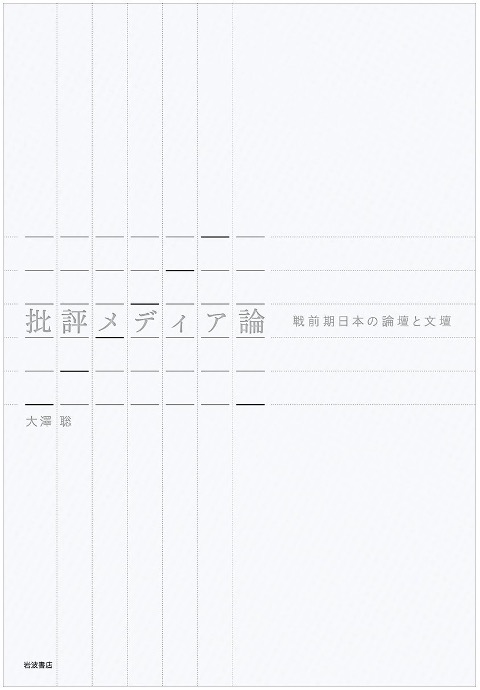Satoshi Ōsawa, A Study on Media of Criticism
Tokyo: Iwanami Shoten, Publishers, 2015.
大澤聡『批評メディア論』
東京:岩波書店、2015年

https://www.iwanami.co.jp/book/b264251.html
This book consists of seven chapters. The table of contents is as follows: “Introduction On Editing and Criticism”(編集批評論); “Chapter 1: On Commentary on Current Events of ‘Rondan’” (論壇時評論); “Chapter 2: On Commentary on Current Literature” (文芸時評論); “Chapter 3: On Symposiums”(座談会論); “Chapter 4: On Criticizing Characters”(人物批評論); “Chapter 5: On Anonymous Criticism” (匿名批評論); “Conclusion: On Environment of Criticism”(批評環境論).
The aim of this book is to illustrate an overall picture of media in Japan in the 1920s-1930s, primarily magazines and newspapers, where a style of discourse that were called “criticism,” in Japanese “hihyō” (批評), took place. Beginning with an inquiry of what makes criticism “criticism”, Ōsawa pays attention to the form of criticism, specifically criticism as media and commodity. Thus, this book puts weight on analyzing the form, namely, the architectural phase, the system itself of criticism, rather than the content (20). The term “media of criticism” (批評メディア) used in the title refers to various styles and forms of articles and publications that grew up during the 1920s-1930s and continue even now (39).
One of the most significant contexts of the formation of “media of criticism,” according to Ōsawa, is the emergence of mass society accompanied by the growth of the publishing market. Publishers turned to a policy of mass-produced and low-priced items to meet the needs of the expanding readership. That policy was made possible by the popularization of higher education during the 1920s in Japan. A typical phenomenon of this trend of publication can be observed in the so-called “yen-pon” boom in the late 1920s. With these kinds of fundamental changes, what Ōya Sōichi (1900-1970) called “the Industrial Revolution in publication,” major magazines like Kaizō and Chūōkōron made notable developments by increasing publications and simplifying content.
The popularization of publication also changed the composition of circles of literati. According to Ōya Sōichi’s observation, “‘Bundan’ as guild” (文壇ギルド) had transformed to “‘Bundan’ based on journalism” (ヂャーナリズム文壇) around 1930 (11-12). In the former, like Kenyūsha (硯友社) which relies on apprenticeship, it is essential to be approved by the literary authorities; while the latter represents the market superiority and requires the examination by commercial journalism. At the same time, a shift from “the age of big intellectuals” to “the age of groups of critics” was occurring (49).
Such changes brought a new stage of media, in which the mutual criticism between newspapers and magazines unfolded. Consequently, a more general, more abstract concept about media was required. This, in Ōsawa’s opinion, would lead to the beginning of media studies though the Japanese word “メディア” – the katakanization of the English word “media” – was not yet used in the 1930s (67-68).
It could be found that the analysis of this book has two axes, one is popularization (or the emergence of mass society) and the other is commodification. As Ōsawa analyzed, since criticism became a kind of commodity, its value lies in its form, instead of its content, and this leads to the consumption of specific named critics and instantaneous criticism. In this sense, the form of criticism as a commodity exactly met the needs of mass society.
Another point that should not be overlooked is that many of the journalists and critics mentioned in this book, like Ōya Sōichi, Ōmori Yoshitarō (1898-1940), Hirano Yoshitarō (1897-1980), Miki Kiyoshi (1897-1945), Tosaka Jun (1900-1945), etc., shared Marxism as an intellectual background and discussed the issue of criticism in their time from a Marxist perspective. Many of them went into journalism because of the exclusion of left-leaning intellectuals by academia (248-249).
Reading through the book, I began to realize that how to grasp the notion “taishū” (大衆) will be the crucial question when we think about the popularization and commodification of criticism. Taking account of the structure of mass society, “taishū” might refer to consumers of a large amount of a commodity, masses who are irrational, enthusiastic, and easily influenced by commercial or political propaganda. On the other hand, as we can see in the case of Japanese Marxist criticism, this notion can be interpreted as a political subject of revolution that consists mainly of the proletariat, which is the oppressed class in capitalist society from the standpoint of Marxism. I think that such ambiguity of “taishū” itself is also one of the conditions of modern-day criticism.
As a side note, I would like to remark on the difficulty of translating some Japanese terms into English. For instance, what is considered to have a very similar meaning with “criticism” in this book is “genron” (言論). But “genron” includes claims, critiques, and discussions published in media such as newspapers and magazines (perhaps television and internet should be added to it considering the technical conditions of the late 20th and 21st century); we can’t find an English equivalent. Not only “genron”, but also words like “genronkai” (言論界), “rondan” (論壇), and “bundan” (文壇) are not easy to translate. Maybe attempting to translate words that seem to be untranslatable is one of the keys to figuring out the characteristics of Japanese media of criticism.
GUO Chiyang (EAA Project Research Fellow)








